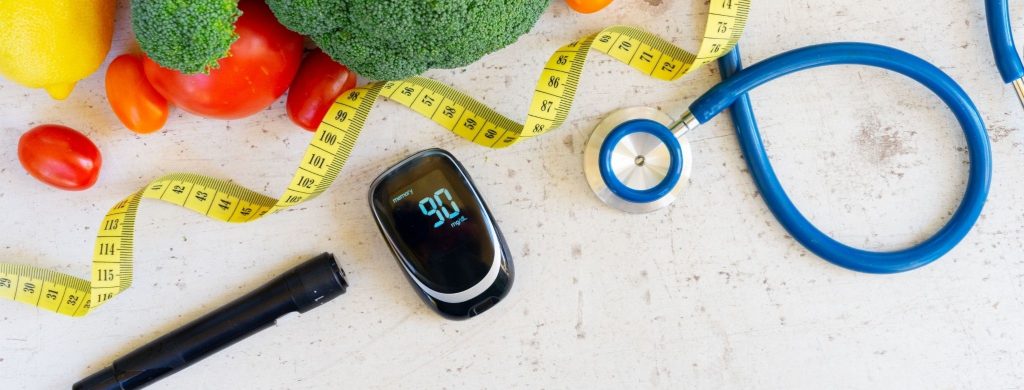In acknowledgment of Diabetes Awareness Month in the United States, our guest expert Gianluca Tongon “The Food Scientist” and Associate Professor in public health at the University of Sweden discusses diabetes and malnutrition in a way many of us never consider. We are grateful for his insight and support of Living Healthy List.
Diabetes Mellitus is one of the most common chronic disorders that affect nearly 415 million people worldwide. Insulin is a hormone released in the body to manage glucose concentration in your blood. When this hormone cannot work properly, the concentration of glucose in the blood increases, leading to high blood sugar levels.
Diabetes Patients are at a Higher Risk of Malnutrition
30.3 million people or 9.4% of the U.S. population has diabetes and many of them suffer from malnutrition. Malnutrition refers to getting too little or too much of certain nutrients. You could be overweight or underweight and not get the nutrition your body needs. This puts diabetic patients at a higher risk for delayed recoveries from illnesses and adversely affects body function, and wellbeing.
People with diabetes are already at an increased risk of poor health because of the other complications associated with the disease. Heart disease, stroke, kidney disease, high blood pressure, and eye damage are just a few of the many complications associated with type 2 diabetes. Even though malnutrition impacts the patients’ overall health, the reality is that it remains undiagnosed and untreated.
It is essential to understand that these patients’ only option is to adhere to a healthy and nutritious diet that could help them gain (or lose) and retain a healthy weight for the rest of their lives.
Factors Contributing to Malnutrition in Diabetic Patients
All physical, social, and medical conditions contribute to the increased risk of malnutrition in diabetic patients. For instance, ill-fitting dentures, dysphagia, eating disorders, and limited knowledge of diet and cooking skills are all significant factors that promote malnutrition in Type-2 diabetic patients.
With the aid of their doctor and clinical nutritionist all diabetic patients, especially those diagnosed with malnutrition can benefit from following a well-designed dietary plan with clearly stated treatment goals.
Older adults and Type 2 diabetes
Often, we have seen and heard that older people specifically have overweight and obesity problems linked to their diagnosis of Type 2 diabetes. On the other hand, people aged 60 and above are equally susceptible to being underweight. They may not completely fulfill the nutritional requirements to maintain optimal body weight while dealing with Type 2 diabetes, which can lead to an increased risk of mortality.
Moreover, diabetic older people living in healthcare facilities and nursing homes are more at risk of being affected by the ongoing pandemic, COVID-19, since diabetes is a risk factor. As a result, mortality rates in this group is higher than ever.
Here’s What You Can Do
How can you reach a healthy weight while struggling with diabetes? If you are underweight and suffer from Type 2 Diabetes, you can make some changes to your diet to increase your body weight. However, you need to make sure that any changes you make to your diet will not significantly impact your blood sugar levels. So, here’s what you can do to gain some pounds healthily.
Note your calorie intake
If you want to gain weight, your diet should contain more calories than are used in your daily activities. Around 500 extra calories are needed daily to achieve approximately 1 pound of weight gain in one week. Essentially it’s the opposite f you need to lose weight. Moreover, you can track your calorie intake by communicating with your nutritionist or a dietician.
Eat consistently throughout the day
You can take small but energy-dense meals at regular intervals over the day to maximize your energy intake. The meals you have should be concentrated on healthy fats to meet the nutritional requirements for the day and provide energy for daily functioning.
Eat products containing healthy fat
To gain weight the consumption of food products rich in healthy fat can significantly change your diet to increase your weight. You can include full-fat dairy products, like milk, cheese, and yogurt in your daily diet. If you need to lose weight omit these items. Avocados, nuts, and seeds also contain healthy fat content that you can eat. Be sure to measure and weigh for accurate calorie counting.
Choose food that will not make your blood sugar level spike
There are food options that can help you to gain weight without causing blood sugar level spikes. These include foods high in protein, such as meat, eggs, poultry, legumes, eggs, and dairy.
The idea is to divide your consumption so that you don’t have to consume lots of food at a single go. Apart from that, it’s also important to always eat your meals regularly (even if you’re not hungry), especially if you have a reduced appetite.
Fruits and fresh vegetables have a high fiber content that can help maintain a healthy gut microflora. Also, coconut, nut butter, avocado are some other food that can boost your daily calorie consumption, which works perfectly as a high-energy snack between lunch and dinner, for instance.
Increase your protein intake
Surprisingly, older people have higher protein requirements compared to younger individuals. You can increase the amount of protein in your diet by eating chicken, turkey, eggs, etc. Also, plant-based proteins, for example, beans, soy, and lentils, have good protein content.
Protein helps prevent sarcopenia, a common health condition that starts during adulthood and continues for the rest of your life. Sarcopenia is a process where the muscle is replaced by fat mass and can be slowed down by increasing protein content, including whey protein used by athletes.
Exercise
Daily strength exercises can help with weight gain by adding weight to your muscles. You can exercise using weight machines, resistance bands, etc. to put on some healthy weight. Please click here to access information on at-home workouts.
Some daily meal ideas for underweight diabetics
Here are some of the meals you can include in your daily menu to gain some healthy pounds.
Milk and rusks (300kcal): 100g of whole milk, which can be soaked with 3 wholemeal rusks.
Avocado smoothie (300kcal): Take 50g of apple, half an avocado, 50g of carrots, and 2tbsp of almond cream and peanuts. Put them in a blender and blend well to create a nutritious avocado smoothie.
Rice and tuna (400kcal): Boil 50g of brown rice. Take 30g of tuna and season it with salt and pepper. Then, cook the tuna in 1tbsp olive oil.
Chicken and olives (400kcal): Take 1tbsp of onion and brown it. Add 150g of a whole chicken (without bones) and cook until it is brown on all sides. Add 1tbsp of white wine, sliced olives, salt, and pepper. Once the meal is ready, sprinkle it with some oregano.
Vegetable quinoa (400kcal): Take 50-55g of quinoa and boil it. Season it with 2tbsp of extra virgin olive oil, lemon juice, and mixed vegetables cut into small pieces. You can use some oil to sauté the vegetables, then pour the quinoa into the pan with the vegetables.
Here is a calculator to easily convert grams into ounces
With some consistent efforts and a few changes in the daily diet, underweight and malnourished diabetic patients can gain weight without increasing their blood glucose levels. It is important to monitor unhealthy carbohydrates (refined grains, white rice, pretzels, and chips) and consumption of food products with added sugar (sweetened cereals, fruit juice, donuts, and cookies) to avoid any complications in your body.
Again it is essential to work with your doctor and an accredited nutritionist for concerns and management of type 2 diabetes and managing your weight.
About the Author
Gianluca Tognon, the founder of the Swedish company “The Food Scientist” and Associate Professor in public health at the University of Skövde (Sweden), is an expert in public health, nutrition, and food science. Gianluca has worked for several years as a researcher in public health and nutrition in both Italy and Sweden. He has collaborated with private companies, schools, organizations, and coached hundreds of men and women to help them lose weight by eating a healthy diet. Gianluca has presented at several conferences and events in Europe and the USA. Co
More information about Gianluca is available at  www.gianlucatognon.com/about
www.gianlucatognon.com/about

Many thanks to our guest blogger for their contribution to Living Healthy List. Are you interested in submitting an article? Click here to connect. https://www.livinghealthylist.com/collaborate-with-us/

